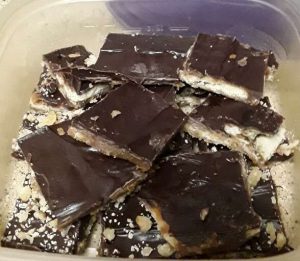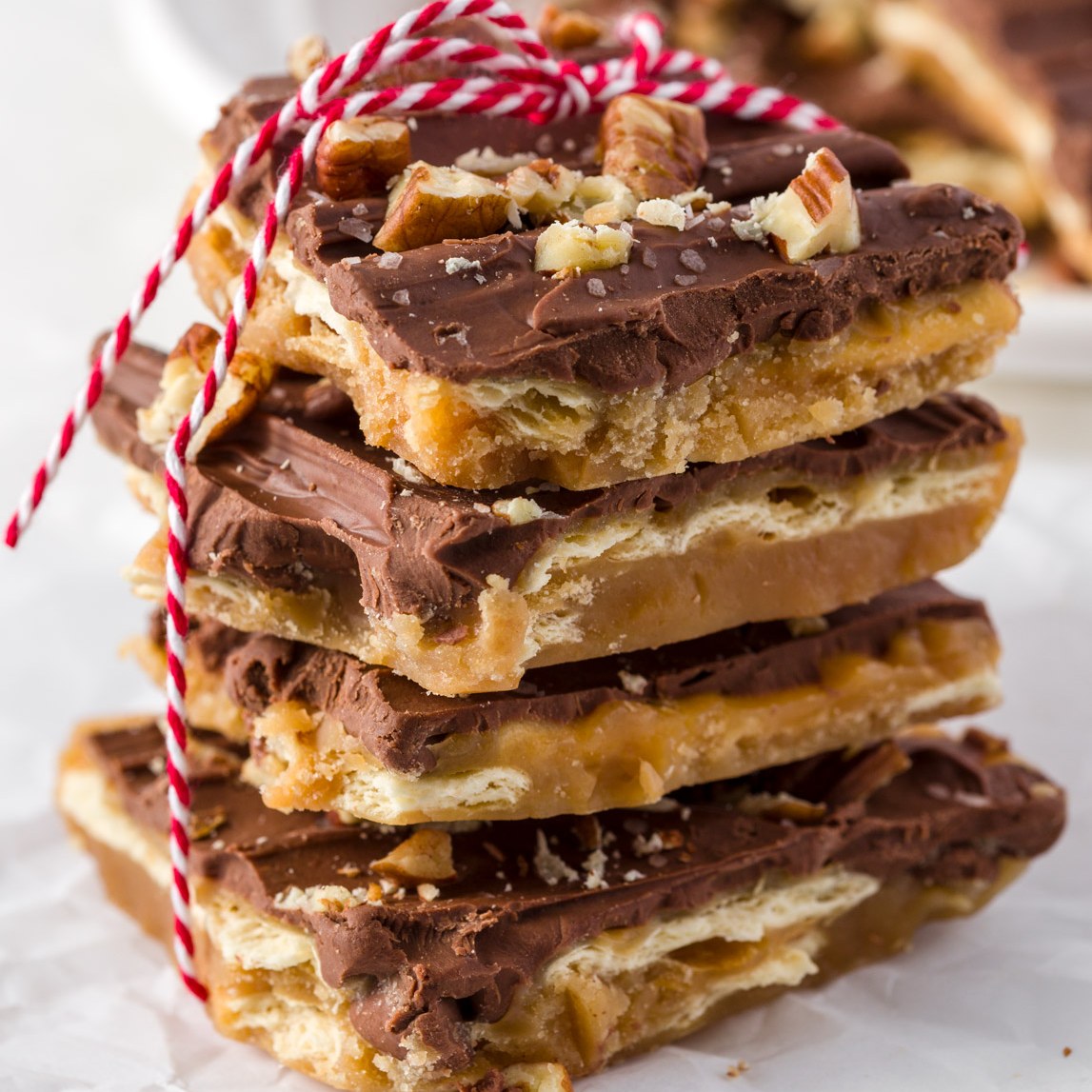Overview of Christmas Crack
Christmas Crack, a festive treat that has captivated the hearts of many during the holiday season, is a delightful combination of simple ingredients that creates an irresistible snack. Known for its perfect balance of sweet and salty flavors, this easy-to-make confection consists of a layer of crackers covered in caramelized toffee and rich chocolate. Its simplicity, coupled with its addictive taste, has made Christmas Crack a popular choice for holiday gatherings, gift exchanges, and cozy winter evenings. The treat’s name, often bringing a smile or a curious glance, reflects its addictive nature and the joy it brings during the festive season.
The Irresistible Appeal of Christmas Crack
The allure of Christmas Crack lies in its unique blend of flavors and textures that appeal to a wide range of palates. The crispness of the crackers, combined with the smooth, buttery toffee and the rich, melted chocolate, creates a multi-sensory experience that is hard to resist. This treat is not only a favorite because of its delicious taste but also for its ease of preparation, making it accessible to bakers of all skill levels. The addictive nature of Christmas Crack often leads to it being the first treat to disappear at holiday parties, and its versatility allows for various toppings and flavor combinations, making each batch a new adventure.
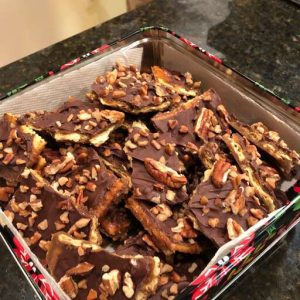
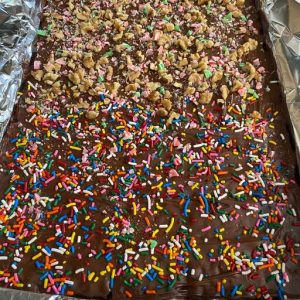

History and Origin of Christmas Crack
The exact origins of Christmas Crack are somewhat shrouded in mystery, but it is believed to have emerged as a holiday favorite in the early 2000s. This simple yet ingenious creation is thought to have been inspired by traditional toffee and brittle recipes, adapted to include everyday ingredients like saltine crackers. The name “Christmas Crack” itself is a testament to its addictive quality and the joy it brings during the holiday season. Over the years, it has become a staple in holiday baking, with families passing down their own variations and secrets to making the perfect batch. The treat’s popularity has grown not just because of its delicious taste but also due to its ease of preparation, making it a go-to recipe for last-minute holiday gatherings and homemade gift-giving.
Key Ingredients of Christmas Crack
The magic of Christmas Crack lies in its simplicity and the perfect harmony of its key ingredients. The base of the treat is typically made with saltine crackers, which provide a crisp and slightly salty foundation. The next layer is a rich, caramelized toffee, created by boiling together butter and brown sugar to a precise consistency. This golden, sticky mixture is poured over the crackers and baked to create a crunchy, sweet layer. The final touch is a layer of melted chocolate, which can be either semi-sweet, milk, or dark chocolate, depending on personal preference. This chocolate layer not only adds a rich depth of flavor but also serves as a canvas for various toppings, such as nuts, sprinkles, or crushed candy, allowing for endless customization and creativity in each batch.
When discussing the importance of quality ingredients, link to the Brownie Mix Ingredients article to help readers understand the components of their favorite desserts.
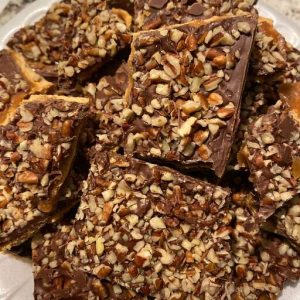
Step-by-Step Guide to Making Christmas Crack
Making Christmas crack is a straightforward process that requires minimal ingredients and no special equipment. Here’s a step-by-step guide to creating this festive treat:
Preparation:
Preheat your oven to 400 degrees Fahrenheit (200 degrees Celsius). Line a baking sheet with aluminum foil, and lightly grease it with cooking spray. This will prevent sticking and make cleanup easier.
Arranging the crackers:
Lay saltine crackers in a single layer on the prepared baking sheet, covering the entire surface. The crackers will form the base of your Christmas Crack.
Making the Toffee:
In a medium saucepan, combine one cup of butter and one cup of packed brown sugar. Cook over medium heat, stirring constantly until the mixture comes to a boil. Once boiling, reduce the heat and simmer for about 5 minutes, until the mixture thickens and turns a deep caramel color.
Baking the base:
Pour the hot toffee mixture over the crackers, spreading it evenly with a spatula. Place the baking sheet in the preheated oven and bake for 5 minutes. The toffee will bubble and further caramelize during this time.
Adding Chocolate:
Remove the baking sheet from the oven and immediately sprinkle chocolate chips over the hot toffee. Wait a few minutes for the chocolate to soften, then spread it evenly over the toffee layer with a spatula.
Customizing:
While the chocolate is still warm, add your choice of toppings. This could be anything from chopped nuts and holiday sprinkles to crushed candy canes for a festive touch.
Cooling and Breaking:
Allow the Christmas crack to cool completely. You can speed up this process by placing the baking sheet in the refrigerator. Once set, break the sheet into irregular pieces.
Serving and Storing:
Serve your Christmas crack as a delightful holiday snack. Store any leftovers in an airtight container at room temperature to maintain their crispness.
Enjoy your homemade Christmas Crack, a treat that’s sure to bring joy and sweetness to your holiday celebrations.
For those who love combining sweet and salty flavors, link to Recipstep’s Slutty Brownies recipe for another delicious treat.
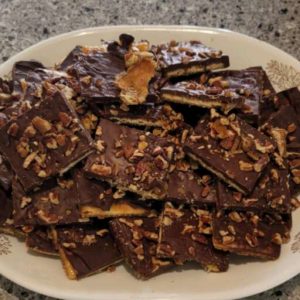
Creative Variations of Christmas Crack
Christmas Crack’s basic recipe is a canvas for culinary creativity. One popular variation is using different types of crackers as a base, such as Graham crackers for a sweeter touch or Ritz crackers for extra butteriness. Chocolate lovers might opt for a double chocolate version, using dark chocolate as the topping and adding chocolate chips to the toffee mixture. For a festive look, sprinkle crushed candy canes or holiday-themed sprinkles on top. Nut enthusiasts can add a layer of chopped almonds, walnuts, or pecans for a crunchy texture. For those who enjoy a hint of fruitiness, dried cranberries or chopped dried apricots offer a tart contrast to the sweet toffee. A drizzle of white chocolate or caramel can add an extra layer of decadence. These variations not only enhance the flavor profile but also make each batch of Christmas Crack uniquely delightful.
Tips for Perfect Christmas Crack Every Time
Achieving the perfect Christmas crack requires attention to detail. First, ensure the crackers are tightly packed on the baking sheet to prevent gaps in the toffee layer. When boiling the butter and brown sugar, aim for a rich amber color and a thick consistency before pouring it over the crackers. This ensures a crunchy, not chewy, toffee layer.
Baking time is crucial; overbaking can lead to a burnt taste, while underbaking may result in a soft toffee. Once out of the oven, add the chocolate chips immediately so they melt evenly. For spreading the chocolate, use an offset spatula for a smooth finish. If adding toppings, do so while the chocolate is still warm so they adhere properly.
Let the Christmas crack cool completely in the refrigerator before breaking it into pieces. This step is essential for achieving the signature snap. Lastly, experiment with baking times and temperatures according to your oven, as they can vary.
Storing and Preserving Christmas Crack
Proper storage is key to maintaining the freshness and texture of Christmas crack. Once completely cooled and set, break it into pieces and store in an airtight container. To keep it crisp, store it at room temperature in a cool, dry place away from direct sunlight. If your environment is warm or humid, refrigerating Christmas crack can prevent it from becoming sticky. In the refrigerator, it can last up to two weeks. For longer storage, Christmas crack can be frozen. Place it in a freezer-safe container, separating layers with parchment paper to prevent sticking. It can be stored in the freezer for up to a month. When ready to serve, let it thaw at room temperature for a few minutes. Avoid frequent temperature changes, as this can cause the chocolate to bloom or the toffee to soften.
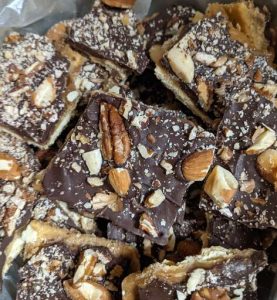
FAQs
Q: Can I make Christmas crack gluten-free?
A: Yes, simply use gluten-free crackers as the base to make a gluten-free version.
Q: How can I prevent the toffee layer from being too hard or chewy?
A: Cook the toffee mixture to the right consistency and ensure it’s evenly spread over the crackers. Avoid overcooking, as this can make it too hard.
Q: Can I make Christmas crack in advance?
A: Absolutely! Christmas crack can be made a few days in advance and stored properly to maintain its freshness.
Q: Is it possible to make a vegan version of Christmas Crack?
A: Yes, use vegan butter and dairy-free chocolate chips to create a vegan version.
Q: How do I ensure the chocolate layer doesn’t separate from the toffee?
A: Make sure to add the chocolate chips while the toffee is still hot and spread them gently to form a cohesive layer.
Q: Can I use different types of chocolate for the topping?
A: Definitely! Feel free to experiment with milk, dark or white chocolate, or a combination of them.
Q: What are some creative topping ideas for Christmas crack?
A: Toppings like crushed nuts, sea salt, dried fruit, mini marshmallows, or different types of sprinkles can add unique flavors and textures.
Q: How do I cut Christmas crack into neat squares?
A: For neater pieces, score the toffee layer with a knife before it completely sets. However, traditionally, Christmas crack is broken into irregular pieces for a rustic look.
Q: Can I double the recipe for a larger batch?
A: Yes, you can easily double the recipe. Just ensure you have a large enough baking sheet to accommodate the extra crackers.
Q: How do I prevent the bottom cracker layer from getting soggy?
Bake the Christmas crack just long enough for the toffee to set without making the crackers soggy. Proper storage is also key to keeping the crackers crisp.
To offer more historical context on popular desserts, include a link to the History of Brownies article, providing readers with a deeper appreciation of holiday sweets.
